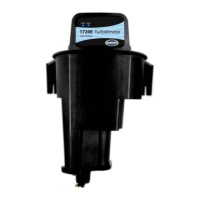General Information
7
2.3 Theory of Operation
The 1720E Turbidimeter measures turbidity by directing a strong beam of
collimated light from the sensor head assembly down into the sample in the
turbidimeter body. Light scattered at 90° relative to the center line of incident light
by suspended particles in the sample is detected by the submerged photocell
(see Figure 1).
Figure 1 90 Degree Detector
The amount of light scattered is proportional to the turbidity of the sample. If the
turbidity of the sample is negligible, little light will be scattered and detected by the
photocell and the turbidity reading will be low. High turbidity, on the other hand, will
cause a high level of light scattering and result in a high reading.
Sample enters the turbidimeter body and flows through the baffle network of the
bubble trap. The flow allows bubbles to either cling to surfaces of the baffle system
or rise to the surface and vent to atmosphere. After traveling through the bubble
trap, sample enters the center column of the turbidimeter body, rises into the
measuring chamber and spills over the weir into the drain port. A reading is taken
once per second.

